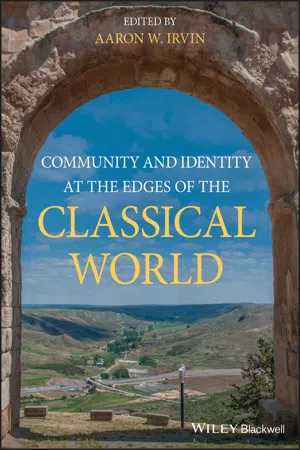
- English
- ePUB (mobile friendly)
- Available on iOS & Android
Community and Identity at the Edges of the Classical World
About This Book
A timely andacademically-significantcontribution to scholarship oncommunity, identity, and globalization in the RomanandHellenistic worlds
Community and Identity at the Edges of the Classical World examinestheconstruction ofpersonal and communal identities in the ancient world, exploringhow globalism, multi-culturalism, and other macro events influencedmicro identitiesthroughout the Hellenistic and Roman empires. This innovative volumediscusseswhere contact and the sharing of ideas was occurringin the time period, and appliesmodern theories based on networks and communication to historical and archaeological data.Anew generation of internationalscholarschallenge traditional views ofClassicalhistoryand offer original perspectives on the impact globalizing trends had on localized areas—insights that resonate with similar issues today.
Thissingular resourcepresents a broad, multi-national view rarely found inwesterncollected volumes, includingSerbian, Macedonian, andRussianscholarship onthe Roman Empire, as well as onRoman and Hellenistic archaeological sites in Eastern Europe. Topics includeEgyptianidentity intheHellenisticworld, culturalidentity in Roman Greece, Romanization in Slovenia, Balkan Latin, theprovincial organization of cults in Roman Britain, andSoviet studies of Roman Empire and imperialism.Serving as asynthesisofcontemporary scholarshiponthewidertopic of identity and community, this volume:
- Provides an expansive materialist approach to the topic of globalization in the Roman world
- Examines ethnicity in the Roman empire from the viewpoint of minority populations
- Offers severalviews ofmetascholarship, a growing sub-discipline that compares ancient material to modern scholarship
- Covers a range of themes, time periods, and geographic areas not included in most western publications
Community and Identity at the Edges of the Classical World isa valuable resource for academics, researchers, and graduate students examining identity and ethnicity in the ancient world, as well asforthose working in multiple fields of study, from Classical, Hellenistic, and Roman historians, to the study of ethnicity, identity, and globalizing trends in time.
Frequently asked questions
Information
1
The beauty of the Oikumene has two edges: Nurturing Roman Imperialism in the “Glocalizing” traditions of the East
Hellenistic Globalization
Table of contents
- Cover
- Table of Contents
- Title Page
- Copyright Page
- List of Tables
- List of Illustrations
- List of Contributors
- Introduction
- 1 The beauty of the Oikumene has two edges: Nurturing Roman Imperialism in the “Glocalizing” traditions of the East
- 2 “Triggered identity”: The use of Macedonian ethnic by Blaundos in confrontation with the Roman Empire
- 3 The population of Siscia in the light of epigraphy
- 4 Roman presence in Athens in the light of epigraphic sources
- 5 Global and local in the sanctuary of the Egyptian Gods in Marathon:
- 6 Consciousness of connectivity: Roman temples in southern Syria
- 7 Macedonian, Greek, or Egyptian? Navigating the royal additive identities of Ptolemy I Soter and Ptolemy II Philadelphus
- 8 Being Mithraist: Embracing ‘other’ in the Roman cultural milieu
- 9 “There are always two sides to every story”: Roman rule, cultural continuities and ethnic identity in southern Hispania
- 10 Unlocking ritual performances in the Romano‐British countryside: How small finds and structured deposits enrich our understanding of provincial priesthoods
- 11 Purification through puppies: Dog symbolism and sacrifice in the Mediterranean world
- 12 Communities at the edges of the Roman world: The perception of identity in the Roman Iron Age Barbaricum
- 13 Deconstructing “Balkan Latin”
- 14 The importance of being earnest: Why precise language matters
- 15 The dictatorship of identity: Soviet scholarship and Roman imperialism
- Index
- End User License Agreement